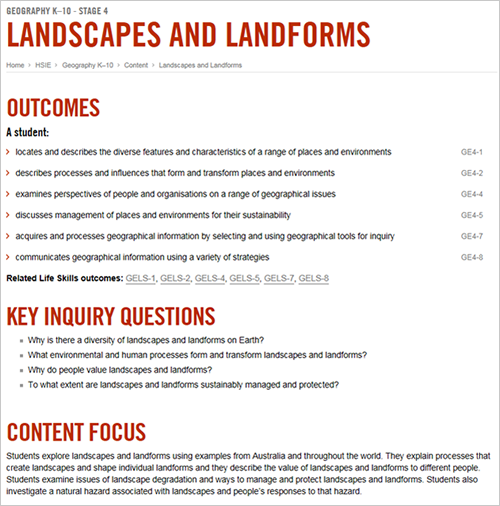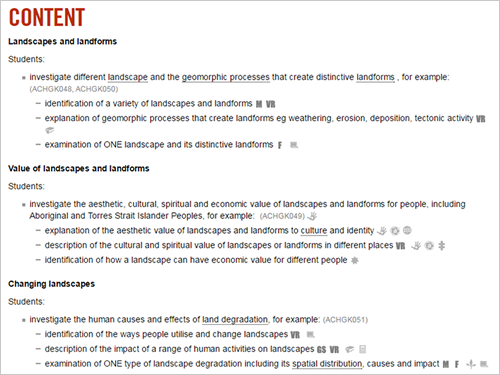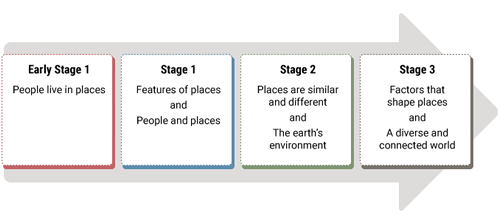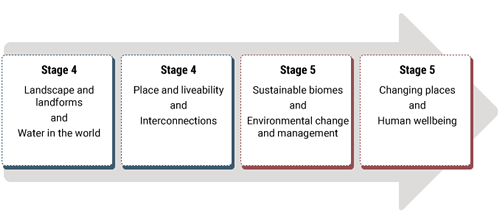Syllabus content (accessible version)
Slide 1: Introduction
There are no introductory notes for this slide show.
Slide 2: Stage-based organisation — two parts
-
Content summary
-
overview at the beginning of each stage
-
descriptions of the geographical concepts, skills and tools to be taught throughout the stage.
-
-
Focus area
-
outcomes referenced in each focus area
-
key inquiry questions
-
content focus description
-
content, including the Australian curriculum descriptions and intended learning
-
includes annotations to learning across the curriculum content.
-
The syllabus content of each stage is organised into two parts.
Part 1: The content summary at the beginning of the stage describes the learning for the whole stage and provides details of the geographical concepts, skills and tools to be used throughout the teaching of focus area content.
Part 2 is organised into the focus areas for each stage, with one focus area for Early Stage 1, two for Stages 1, 2 and 3, and four each for Stages 4 and 5. Each focus area details the outcomes and key inquiry questions, provides an overview, and organises the content under subheadings. Below each subheading are dot points of the Australian curriculum content followed by examples of the intended learning.
Slide 3: Key inquiry questions
There are 3–4 key inquiry questions for each focus area in the geography syllabus.
Stage 3
Key inquiry questions for ‘Factors that shape places’:
-
How do people and environments influence one another?
-
How do people influence places and the management of places?
-
How can the impact of bushfires on people and places be reduced?
Key inquiry questions have been developed as part of the Australian curriculum: Geography. The term ‘key’ refers to the inquiry questions stated in the syllabus. Teachers will develop a variety of additional localised inquiry questions. Some of these will be recorded while others will be asked strategically in the classroom to develop and enhance student understanding.
Use of the terms ‘key’ and ‘inquiry questions’ should be consistent with the syllabus. Avoid using terminology based on previous practise, such as ‘focus’ or ‘contributing questions’.
Key inquiry questions can be used by teachers in a variety of ways, depending on the learning needs of students and the case studies used to address the syllabus content descriptions. However, by the end of learning about a focus area, students should be able to respond to each key inquiry question through the learning they have engaged with.
Slide 4: Structure and organisation: focus area
The main features of the Geography K–10 Syllabus content focus page (below) are identified:
-
Outcomes are coded and linked to content.
-
Related Life Skills outcomes link to the Life Skills syllabus
-
Key inquiry questions provide a focus for teaching and learning.
-
The content focus provides the scope of learning.

The syllabus structure is the same for each K–10 focus area. This example shows information for the Stage 4 focus area, Landscapes and landforms.
Outcomes are listed underneath the stem ‘A student:’. These are coded to the content, meaning the syllabus content descriptions need to be addressed to meet the outcomes.
In Stages 4 and 5, Life Skills outcomes are also listed for each focus area. These link to the adapted syllabus content for the Life Skills course. This is a specific 7–10 feature of the syllabus.
Four key inquiry questions are listed for this focus area.
A brief summary of the scope of learning is provided under the heading ‘Content focus’.
Slide 5: Structure and organisation: content
The main features of content section of the Geography K–10 Syllabus content focus page (below) are identified.
-
Content describes the intended learning.
-
Icons identify opportunities to integrate geographical tools.
-
Icons identify the incorporation of learning across the curriculum content.
-
Codes identify Australian curriculum content descriptions.
-
Underlined words link to the glossary.
-
Examples of the intended learning are included.

This slide shows the ‘Content’ information for the Stage 4 focus area, Landscapes and landforms. The focus area content is listed as dot points with a second level of dash points. The word ‘content’ is used in various contexts throughout the syllabus. Make sure that the colleagues you are working with are literally on the same page when talking about ‘content’.
Dot points reference the Australian curriculum (AC) content and include the AC codes at the end. Each dot point ends with ‘for example’.
The second level of dash points underneath provide examples of intended learning. The wording of these dash points may need to be adjusted to ensure that the geographical issue or problem being investigated through a selected context or case study will make sense. Opportunities to address geographical tools and learning across the curriculum content areas are identified by icon at the end of each intended learning statement.
You do have some flexibility in the emphasis and sequence with which you develop student learning referenced to the intended learning of the syllabus.
Slide 6: K–6 content focus

Early Stage 1: People live in places
Stage 1: Features of places, People and places
Stage 2: Places are similar and different, The earth’s environment
Stage 3: Factors that shape places, A diverse and connected world.
Early Stage 1: People live in places is the only focus area for this stage. Two outcomes and three key inquiry questions organise learning. The focus is on places they are familiar with, and the care of these places, inclusive of Aboriginal and Torres Strait Islander Peoples. Visual representation of places and descriptions of the location of places begins. Using geographical terminology is an important part of this learning.
Stage 1: Features of places is the first focus area with three outcomes and key inquiry questions. It is about the natural and human features of places, the organisation and care of places and the impact of weather and seasons. People and places is the second focus area with two outcomes and three key inquiry questions. This focus area is about places within Australia and Australia’s location in the world and the connection people have with these places.
Stage 2: The first focus area, Places are similar and different, has four outcomes and three key inquiry questions. Students looks at the natural and human features of Australia, and the characteristics of neighbouring countries including climate, settlement patterns and information about the people who live there, to imagine what it would be like to live in other places. The perception people have of these places is also investigated with reference to specific examples both within Australia and in nearby countries. The Earths’ environment, the second focus area, also has four outcomes and three key inquiry questions. Students examine the interconnection between climate, vegetation and native animals in Australia and Asia and the value attached to these environments. They identify sustainable practises and perspectives on sustainability.
Stage 3: The first focus area, Factors that shape places, has four outcomes and three key inquiry questions. It looks at how people change environments in Australia and other countries. The interconnection between people and the environment influences how people live and manage the environment in different places. Students examine the impact of one contemporary bushfire hazard in Australia and how the impact of bushfires can be minimised. A diverse and connected world is the second focus area with three outcomes and three key inquiry questions. This focus area examines countries in Asia and the connections Australia has globally. The diversity of people, including Indigenous peoples is examined with an emphasis on developing intercultural understanding.
Slide 7: 7–10 content focus

Stage 4: Landscapes and landforms, Place and liveability, Water in the world and Interconnections
Stage 5: Sustainable biomes, Changing places, Environmental change and management and Human wellbeing
Stage 4: Landscapes and landforms is the first focus area. Landscapes and landforms are explored, including their geographical processes, value, protection and management, using examples from Australia and the world. It is in this focus area that students investigate a geomorphic hazard associated with a landscape, and people’s responses to this hazard. Place and liveability is the second focus area. The features and characteristics of places across a range of scales are investigated, including the perceptions of places and the access to services and facilities. Students assess the liveability of places and propose strategies to enhance the liveability of a place in Australia. In the third focus area, Water in the world, students study water as a resource. The atmospheric and hydrologic processes that shape and transform the environment, factors influencing water flows, and the availability of water, including water scarcity, are investigated. Students study an atmospheric or hydrologic hazard, including people’s responses to this hazard. Interconnections is the fourth and final focus area for Stage 4. An investigation of people’s connections to places at a variety of scales is undertaken. Additionally in this focus area, students explore the transportation, technological and trade links between people. Finally, the impacts and effects of the local, national and international production and consumption of goods and services are examined.
Stage 5: Sustainable biomes is the first focus area in Stage 5. In this focus area the physical characteristics, spatial distribution and productivity of biomes are examined. An investigation of the impact humans have on biomes is undertaken. A focus on food production, food security and their associated challenges occurs. Changing places is the second focus area. Here students examine urbanisation, population movements, trends and patterns. They are urged to develop strategies to create liveable and sustainable urban places. Active citizenship is developed in this focus area. Environmental change and management is the third focus area for Stage 5 geography. In this focus area the function of natural environments is revisited along with the notion of human-induced environmental change. Students explore worldviews in approaching environmental use and management. An in-depth investigative study of the causes and consequences of environmental change in an environment in Australia compared to another country is undertaken. Human wellbeing is the fourth and final focus area for Stage 5. Students examine the nature of, and differences in human wellbeing and development that exist within and between countries. They investigate the causes, issues and consequences of spatial variation in human wellbeing, using examples from Australia and throughout the world. Finally, students discuss and propose local, national and global initiatives to improve human wellbeing after investigating and array of examples of issues of development.